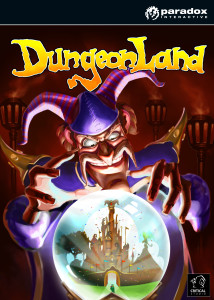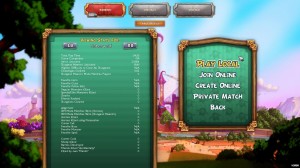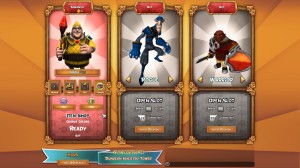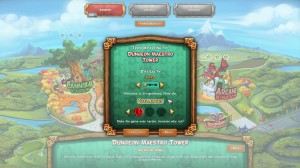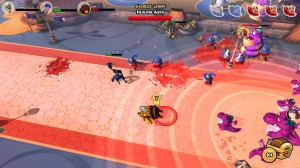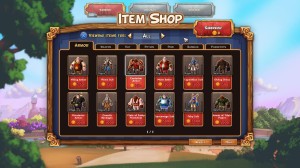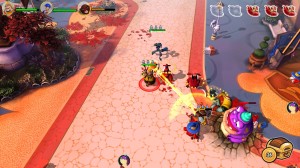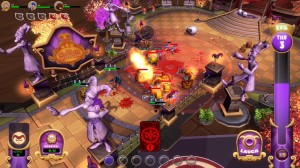If I had to name my favorite arcade game from the 1980’s, it would definitely have to be “Gauntlet.” You picked a character class and waded through hordes of enemies alone or with friends, endeavouring to find your way to the exit. “Dungeonland” reminds me a bit of “Gauntlet: Dark Legacy” (an evolved form of “Gauntlet” for the PS2), mainly because it encourages cooperative play while keeping with the theme we all know and love. Before we don our wizard’s caps and sharpen our swords, I’d like to thank Veronica Gunlycke from Paradox Interactive for providing me with a free review copy.
When the game starts up, you’ll be given the option to choose a screen resolution, toggle fullscreen mode, and select the graphics quality via a window pop-up. Once in-game, you’ll be prompted to create a profile and a default control scheme. From the main menu, you can purchase items in the item shop, view help & game options, and select your inputs. The options menu is very basic, allowing you to change your sound levels and enable hints. Controls are rebindable from here and you can view a quick “how to play” slide show to help prime you for death…erm, your experience. When it comes time to venture forth, players will have the option to go solo with AI bots or team up with real people via local or online multiplayer. Multiplayer can be local, private, or public, which is a nice touch.
“Dungeonland” offers three classes: The Warrior, The Rogue, and The Mage. Each of these classes play a bit differently, allowing a player to pick the role best suited for them. For you gung-ho types that enjoy being on the front lines as a “tank”, the warrior would be an ideal choice. If you’re used to being sneaky and stabbing people in the back for massive damage, then the Rogue would be the way to go. If wielding powerful offensive and defensive magic at range is more your thing, then the Mage will shine with appeal. Each class has a secondary ability, sort of like an “oh crap!” button. The warrior, for example, can block and absorb damage for a short period of time, giving his allies a chance to do their thing.
The game consists of three maps or “theme park environments”, each with their own unique look. While that may not sound like a lot, the game randomizes each play session so that players experience different monsters, rewards, and challenges. Before beginning a new play session, players will able to choose between hard, harder, and impossible difficulty modes…and yes, “hard” is the lowest difficulty to choose from. Players will also be allowed to enable random modifiers that make their lives more difficult in some way. For example, the “high stakes” modifier makes monsters three times as strong. While the warrior-rogue-mage combo during class selecting is recommended, it isn’t necessary. Advanced players may find combinations that they really like, while in turn mixing up the play experience a bit.
In terms of difficulty, the game has a fairly high learning curve. I can’t emphasize enough the importance of teamwork in “Dungeonland.” Going off on your own will get you killed, though players who work together will find the game challenging but not overly so. Until you get used to the classes and how their abilities work together, you may find yourself dying a lot. I’m not going to lie…I did, and still do. Once you get used to how the character classes play and how the game mechanics work however, you’ll find yourself trucking through enemies with (somewhat) relative ease. While the AI bots do their job fairly well, playing with others online adds an extra challenge to the game, mainly because of how important it is to communicate with each other. If you’ve ever been involved in MMORPG dungeon raids, then you’ll know the drill.
One of my favorite features of the game is the ability to unlock perks and abilities, which can be either cosmetic or practical in nature. You’ll earn gold as you play, giving you an incentive to come back for more so that you can unlock a particular perk that might suit your play style. Eventually, players will find a combination that fits them best. I spent countless hours pouring over “Diablo III” and its many character talents…I have a feeling I’ll be doing the same here. A gear system is also present, allowing players to pick up loot they find on the ground or buy it with gold they’ve earned.
With all of the above in mind, players will be making their way across these theme parks with the intent on reaching the end of the current stage. Along the way, they’ll face various monsters that appear via monster spawners, similar to those found in “Gauntlet.” The monsters will keep coming until the spawner is destroyed, so it’s important to coordinate with your fellow heroes appropriately. Mini-bosses make appearances to ruin your day along with random scenarios that might task you with escort missions and the like, something I’ve seen in “Bunch of Heroes.” Players have a limited number of shared lives, adding even more of a challenge to the already high learning curve. Only the most coordinated and skilled folks will prevail on the harder difficulty levels.
Before I finish up, I wanted to give the “Dungeon Maestro” mode a quick mention. It’s not often that I see a game that allows a player to be the bad guy and I must commend the developers for including this feature. It’s refreshing to be able to take control of monsters personally or just sit back and throw enemies at the heroes. I also like that you can customize the loadout of the dungeon master before the match begins…that is, choosing what monsters, spells, bosses, and etc. will be in the game. While you can fly solo in this mode, it’s obviously better if you have a group of friends ready and willing to end your career as the designated dungeon master. Unlike adventure mode, you’ll be able to choose between very easy, easy, normal, hard, and very hard in terms of hero difficulty. The harder the difficulty, the more damage the heroes take.
“Dungeonland” is an excellent example of how a cooperative game should play. It’s fun, it’s addicting, and it’s a great way to spend the evening with a group of friends. The unlock system, coupled with the fact that map objects randomize each run, gives the game huge amounts of replayability. I do think the game could use an easier mode in order to appeal to the casual players, as well as to help newcomers get used to how the game is played. As it stands, casual players might be put off by the high learning curve and difficulty. In my opinion, the game is worth its $9.99 price tag (as of 1/30/13) and then some, especially if you are heavily invested in online cooperative games.
Final Verdict: 7/10
—
You can learn more about and purchase “Dungeonland” by visiting the following websites:
http://www.dungeonlandgame.com/
http://store.steampowered.com/app/218130/
You can view video play sessions here:
http://www.youtube.com/watch?v=i3TU6kws2_c
http://www.youtube.com/watch?v=LV1KCKAaZrk
—

